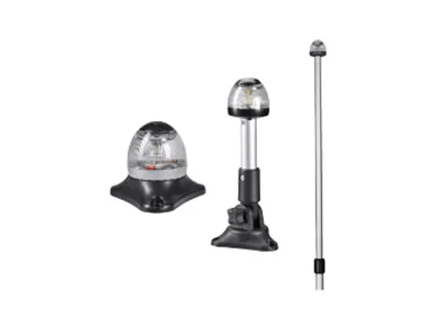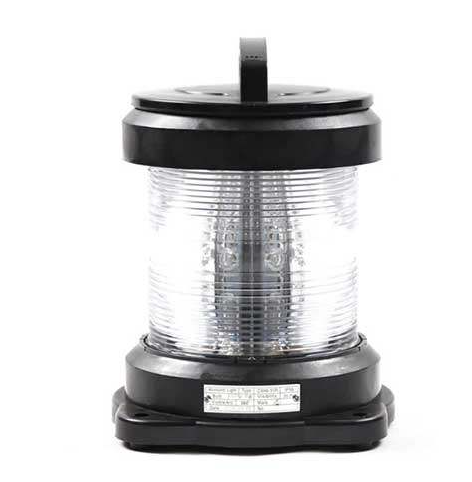When it comes to navigation lights, you may immediately think of mast lights, port lights, stern lights, and runaway lights, etc., as well as the luminous angle of different navigation lights and signal lights, etc., but do you know about marine anchor light?
A masthead anchor light is a type of navigational light installed on the masthead (top) of a boat or vessel. Its primary purpose is to indicate to other vessels the presence and location of an anchored or moored boat during periods of reduced visibility, such as at night or in foggy conditions. These led anchor lights for boats are an important part of maritime safety and navigation, as they help other vessels in the vicinity determine the status and position of an anchored vessel, especially in low visibility conditions or at night.

What lights for ships at anchor?
There are generally two kinds of signs for anchored ships. During daytime, hang the anchor ball at the easily visible place of the bowsprit, when the surrounding ships see it, they will know it is an anchored ship.
At night, turn on the anchor light, (which is a 360 degrees circular white light located at the top of the bowsprit), and at the same time, turn off the navigation lights and turn on all external lights of the ship. Anchoring is not a sailing condition, but the bridge watch should not take it lightly, and should pay close attention to the dynamics of the surrounding ships to avoid accidents.
Before anchoring, especially in the channel on both sides of the anchorage waters restricted anchorage and more crowded anchorage anchoring, also known as fixed-point anchoring, must find the anchor point, to avoid throwing bias, resulting in more than a hundred meters long anchor chain loose after anchoring, plus the length of the boat, the big boat two to three hundred meters, the small boat is also dozens of meters, with the rise and fall of the tide, the boat body may obstruct the channel, accidents.
Fixed anchor, generally the traffic control center are staring, before anchoring to the traffic control center to approve whether the anchor can be anchored, the traffic control approved consent before anchoring, otherwise even a little bit of bias, people will let you re-throw.

How to know the ship throw in the anchor point?
Since most of the GPS and radar antennas of cargo ships are above the aft bridge position, the fixed position of the ship is the position of the bridge, and the anchor is at the bow, so the fixed position of the ship should be added with the distance from the bow to the bridge to be the position of the anchoring point, and this distance data is usually posted on the bridge, which is visible at any time.
Marine anchor lights are typically white in color and have a specific configuration and characteristics defined by international regulations, such as the International Regulations for Preventing Collisions at Sea (COLREGs). Here are some common features include:
All Round Light: An anchor light is usually designed as an all round light, which means it emits light in all directions (360 degrees) to ensure visibility from any angle.
Characteristic: The light is typically a steady, unbroken light, in contrast to other navigational lights, which may have specific patterns of flashing or colors.
Height and Position: The regulations specify the required height above the waterline at which the anchor light should be placed, depending on the size of the vessel.
Visibility Range: The intensity and range of the light are also specified to ensure that it is visible to other vessels at a reasonable distance.
It’s important for mariners to understand and comply with these regulations to ensure safe navigation and to avoid collisions with anchored vessels. Additionally, anchor lights are often used in conjunction with other lights and signals, such as sidelights and stern lights, to convey a vessel’s status and direction to other vessels on the water.
Navigation lights, anchor lights, and mast lights are three types of light fixtures on ships, but do you know the difference among them?
1. Navigation lights: Ships need to turn on the navigation lights at night or when the visibility is not clear to ensure that other ships notice the ship’s position and heading to prevent collision. Navigation lights usually come in two colors, red and green, and are installed on both sides of the ship, as well as white front lights and rear lights. The colors and positions are set according to the standards stipulated in the international maritime agreements.
2. Anchor light: When the ship stops sailing and uses the anchor to moor in a certain position, it is necessary to turn on the anchor light. Anchor light is usually white light, low position, installed in the front and rear of the ship.
3. Masthead light: Masthead light is a light mounted on the transom (mast) of a ship, usually white in color. When sailing at night, the function of masthead light is to increase the height and range of navigation lights, so that other ships can see the ship’s position at a longer distance.
In short, a ship’s navigation lights, anchor lights and mast lights are used to enhance safety of navigation at night and to make other vessels aware of the ship’s position and course. Lights of different colors and positions are set to distinguish the status and direction of the vessel to prevent accidents such as collisions.
Navigation lights, anchor lights and mast lights are three common lights on ships, and their difference lies in the different occasions of use and functions.
Navigation lights are used to indicate the ship’s position, heading and outline, and provide safe navigation for other ships and aircraft at night and in poor visibility.
Anchor lights indicate the position of a ship while at anchor, waiting or towing to avoid accidents caused by other vessels mistaking it for being in motion.
Mast lights are used to indicate the height and type of vessel so that other vessels can recognize and avoid it at a distance.
It should be noted that in some special cases, ships need to use all three lights at the same time to ensure safe navigation.
By carefully evaluating these factors and understanding your specific needs, you can browse BOZHOU’S website to find your desired marine tube light that enhances safety and visibility on your vessel.